Crop Residue Burning Emissions and the Impact on Ambient Particulate Matters over South Korea
Abstract
1. Introduction
- -
- In energy production, conversion from coal-fired power plants to liquefied natural gas (LNG)-fired plants (i.e., coal-to-gas switching).
- -
- In the industry section, extending the environmental management policy for total amount control of air pollutants from the Seoul Metropolitan area to the whole country.
- -
- In transportation, early scrappage of old diesel vehicles and supply of low-emission vehicles such as electric and hybrid vehicles.
2. Experiments and Methods
2.1. WRF-CMAQ Model Simulations
2.2. Emission Inventory
2.3. Observations
3. Results and Discussion
3.1. Emission Fluxes (E) Estimated from Residue Burning of Crops over South Korea
3.2. Modeling Performances
3.3. Impact of Crop Residue Burning on Particulate Matters
4. Summary and Conclusions
Supplementary Materials
Author Contributions
Funding
Institutional Review Board Statement
Informed Consent Statement
Data Availability Statement
Acknowledgments
Conflicts of Interest
References
- Kim, Y.P.; Lee, G.W. Trend of air quality in Seoul: Policy and Science. Aerosol Air Qual. Res. 2018, 18, 2141–2156. [Google Scholar] [CrossRef]
- Koo, J.H.; Kim, J.; Lee, Y.G.; Park, S.S.; Lee, S.; Chong, H.; Cho, Y.; Kim, J.; Choi, K.; Lee, T. The implication of the air quality pattern in South Korea after the COVID-19 outbreak. Sci. Rep. 2020, 10, 22462. [Google Scholar] [CrossRef] [PubMed]
- Ministry of Environment in South Korea. Available online: http://eng.me.go.kr/eng/web/index.do?menuId=464 (accessed on 21 January 2022).
- World Health Organization. WHO Global Air Quality Guidelines: Particulate Matter (PM2.5 and PM10), Ozone, Nitrogen Dioxide, Sulfur Dioxide, and Carbon Monoxide. Available online: https://apps.who.int/iris/handle/10665/345329 (accessed on 21 January 2022).
- Yevich, R.; Logan, J.A. An assessment of biofuel use and burning of agricultural waste in the developing world. Glob. Biogeochem. Cycles 2003, 17, 1095. [Google Scholar] [CrossRef]
- Wulfhorst, J.D.; Van Tassell, L.; Johnson, B.; Holman, J.; Thill, D. An Industry Amidst Conflict and Change: Practices and Perceptions of Idaho’s Bluegrass Seed Producers; University of Idaho College of Agricultural and Life Sciences: Moscow, ID, USA, 2006; pp. 1–20. [Google Scholar]
- Lin, N.-H.; Tsay, S.-C.; Maring, H.B.; Yen, M.-C.; Sheu, G.-R.; Wang, S.-H.; Chi, K.H.; Chuang, M.-T.; Ou-Yang, C.-F.; Fu, J.-S.; et al. An overview of regional experiments on biomass burning aerosols and related pollutants in Southeast Asia: From BASE-ASIA and the Dongsha Experiment to 7-SEAS. Atmos. Environ. 2013, 78, 1–19. [Google Scholar] [CrossRef]
- Zhou, L.; Baker, K.R.; Napelenok, S.L.; Pouliot, G.; Elleman, R.; O’Neill, S.M.; Urbanski, S.P.; Wong, D.C. Modeling crop residue burning experiments to evaluate smoke emissions and plume transport. Sci. Total Environ. 2018, 627, 523–533. [Google Scholar] [CrossRef] [PubMed]
- Jethva, H.; Torres, O.; Field, R.D.; Lyapustin, A.; Gautam, R.; Kayetha, V. Connecting crop productivity, residue fires, and air quality over Northern India. Sci. Rep. 2019, 9, 16594. [Google Scholar] [CrossRef] [PubMed]
- Takami, K.; Shimadera, H.; Uranishi, K.; Kondo, A. Impacts of Biomass Burning Emission Inventories and Atmospheric Reanalyses on Simulated PM10 over Indochina. Atmosphere 2020, 11, 160. [Google Scholar] [CrossRef]
- Das, B.; Bhave, P.V.; Puppala, S.P.; Shakya, K.; Maharjan, B.; Byanju, R.M. A model-ready emission inventory for crop residue open burning in the context of Nepal. Environ. Pollut. 2020, 266, 115069. [Google Scholar] [CrossRef] [PubMed]
- Crutzen, P.J.; Andreae, M.O. Biomass burning in the tropics: Impact on atmospheric chemistry and biogeochemical cycles. Science 1990, 250, 1669–1678. [Google Scholar] [CrossRef] [PubMed]
- Reisen, F.; Meyer, C.P.; Keywood, M.D. Impact of biomass burning sources on seasonal aerosol air quality. Atmos. Environ. 2013, 67, 437–447. [Google Scholar] [CrossRef]
- Agarwal, R.; Awasthi, A.; Mital, S.K.; Singh, N.; Gupta, P.K. Statistical model to study the effect of agriculture crop residue burning on healthy subjects. MAPAN-J. Metrol. Soc. India 2014, 29, 57–65. [Google Scholar] [CrossRef]
- Awasthi, A.; Agarwal, R.; Mittal, S.K.; Singh, N.; Singh, K.; Gupta, P.K. Study of size and mass distribution of particulate matter due to crop residue burning with seasonal variation in rural area of Punjab, India. J. Environ. Monit. 2011, 13, 1073–1081. [Google Scholar] [CrossRef] [PubMed]
- Chen, Y.; Xie, S. Characteristics and formation mechanism of a heavy air pollution episode caused by biomass burning in Chengdu, Southwest China. Sci. Total Environ. 2014, 473–474, 507–517. [Google Scholar] [CrossRef] [PubMed]
- Yang, S.; He, H.; Lu, S.; Chen, D.; Zhu, J. Quantification of crop residue burning in the field and its influence on ambient air quality in Suqian, China. Atmos. Environ. 2008, 42, 1961–1969. [Google Scholar] [CrossRef]
- Zhang, H.; Ye, X.; Cheng, T.; Chen, J.; Yang, X. A laboratory study of agricultural crop residue combustion in China: Emission factors and emission inventory. Atmos. Environ. 2008, 42, 8432–8441. [Google Scholar] [CrossRef]
- Jain, N.; Bhatia, A.; Pathak, H. Emission of air pollutants from crop residue burning in India. Aerosol Air Qual. Res. 2014, 14, 422–430. [Google Scholar] [CrossRef]
- Andreae, M.O.; Merlet, P. Emission of trace gases and aerosols from biomass burning. Glob. Biogeochem. Cycles 2001, 15, 955–966. [Google Scholar] [CrossRef]
- Stockwell, C.E.; Christian, T.J.; Goetz, J.D.; Jayarathne, T.; Bhave, P.V.; Praveen, P.S.; Adhikari, S.; Maharjan, R.; DeCarlo, P.F.; Stone, E.A.; et al. Nepal Ambient Monitoring and Source Testing Experiment (NAMaSTE): Emissions of trace gases and lightabsorbing carbon from wood and dung cooking fires, garbage and crop residue burning, brick kilns, and other sources. Atmos. Chem. Phys. 2016, 16, 11043–11081. [Google Scholar] [CrossRef]
- Jayarathne, T.; Stockwell, C.E.; Bhave, P.V.; Praveen, P.S.; Rathnayake, C.M.; Islam, M.R.; Panday, A.K.; Adhikari, S.; Maharjan, R.; Goetz, J.D.; et al. Nepal Ambient Monitoring and Source Testing Experiment (NAMaSTE): Emissions of particulate matter from wood and dung cooking fires, garbage and crop residue burning, brick kilns, and other sources. Atmos. Chem. Phys. 2018, 18, 2259–2286. [Google Scholar] [CrossRef]
- McCarty, J.L. Remote Sensing-Based Estimates of Annual and Seasonal Emissions from Crop Residue Burning in the Contiguous United States. J. Air Waste Manag. Assoc. 2011, 61, 22–34. [Google Scholar] [CrossRef]
- Turn, S.Q.; Jenkins, B.M.; Chow, J.C.; Pritchett, L.C.; Campbell, D.; Cahill, T.; Whalen, S.A. Elemental Characterization of Particulate Matter Emitted from Biomass Burning: Wind Tunnel Derived Source Profiles for Herbaceous and Wood Fuels. J. Geophys. Res. 1997, 102, 3683–3699. [Google Scholar] [CrossRef]
- Liu, M.; Song, Y.; Yao, H.; Kang, Y.; Li, M.; Huang, X.; Hu, M. Estimating emissions from agricultural fires in the North China Plain based on MODIS fire radiative power. Atmos. Environ. 2015, 112, 326–334. [Google Scholar] [CrossRef]
- Akagi, S.; Yokelson, R.J.; Wiedinmyer, C.; Alvarado, M.; Reid, J.; Karl, T.; Crounse, J.; Wennberg, P. Emission factors for open and domestic biomass burning for use in atmospheric models. Atmos. Chem. Phys. 2011, 11, 4039–4072. [Google Scholar] [CrossRef]
- Wooster, M.J.; Roberts, G.; Perry, G.; Kaufman, Y. Retrieval of biomass combustion rates and totals from fire radiative power observations: FRP derivation and calibration relationships between biomass consumption and fire radiative energy release. J. Geophys. Res. Atmos. 2005, 110, D24311. [Google Scholar] [CrossRef]
- Li, J.; Li, Y.; Bo, Y.; Xie, S. High-resolution historical emission inventories of crop residue burning in fields in China for the period 1990–2013. Atmos. Environ. 2016, 138, 152–161. [Google Scholar] [CrossRef]
- Li, X.G.; Wang, S.X.; Duan, L.; Hao, J.; Li, C.; Chen, Y.S.; Yang, L. Particulate and trace gas emissions from open burning of wheat straw and corn stover in China. Environ. Sci. Technol. 2007, 41, 6052–6058. [Google Scholar] [CrossRef]
- Zhang, Y.; Shao, M.; Lin, Y.; Luan, S.; Mao, N.; Chen, W.; Wang, M. Emission inventory of carbonaceous pollutants from biomass burning in the Pearl River Delta Region, China. Atmos. Environ. 2013, 76, 189–199. [Google Scholar] [CrossRef]
- National Bureau of Statistics of China, 1991–2014. China Statistical Yearbook; China Statistics Press: Beijing, China, 2014. [Google Scholar]
- Wang, X.Y.; Xue, S.; Xie, G.H. Value-taking for residue factor as a parameter to assess the field residue of field crops. J. China Agric. Univ. 2012, 17, 1–8. (In Chinese) [Google Scholar]
- Andela, N.; Van, D.W.; Guido, R.; Kaiser, J.W.; Van Leeuwen, T.T.; Wooster, M.J.; Lehmann, C.E.R. Biomass burning fuel consumption dynamics in the tropics and subtropics assessed from satellite. Biogeosciences 2016, 13, 3717–3734. [Google Scholar] [CrossRef]
- Pouliot, G.; Rao, V.; McCarty, J.L.; Soja, A. Development of the crop residue and rangeland burning in the 2014 National Emissions Inventory using information from multiple sources. J. Air Waste Manag. Assoc. 2017, 67, 613–622. [Google Scholar] [CrossRef]
- Van der Werf, G.R.; Randerson, J.T.; Giglio, L.; van Leeuwen, T.T.; Chen, Y.; Rogers, B.M.; Mu, M.; van Marle, M.J.E.; Morton, D.C.; Collatz, G.J.; et al. Global fire emissions estimates during 1997–2016. Earth Syst. Sci. Data 2017, 9, 697–720. [Google Scholar] [CrossRef]
- Giglio, L.; Randerson, J.T.; van der Werf, G.R. Analysis of daily, monthly, and annual burned area using the fourth generation global fire emissions database (GFED4). J. Geophys. Res.-Biogeo. 2013, 118, 317–328. [Google Scholar] [CrossRef]
- Randerson, J.T.; Chen, Y.; van der Werf, G.R.; Rogers, B.M.; Morton, D.C. Global burned area and biomass burning emissions from small fires. J. Geophys. Res.-Biogeo. 2012, 117, G04012. [Google Scholar] [CrossRef]
- Wu, J.; Kong, S.; Wu, F.; Cheng, Y.; Zheng, S.; Yan, Q.; Zheng, H.; Yang, G.; Zheng, M.; Liu, D. Estimating the open biomass burning emissions in central and eastern China from 2003 to 2015 based on satellite observation. Atmos. Chem. Phys. 2018, 18, 11623–11646. [Google Scholar] [CrossRef]
- He, M.; Wang, X.R.; Han, L.; Feng, X.Q.; Mao, X. Emission Inventory of Crop Residues Field Burning and Its Temporal and Spatial Distribution in Sichuan Province. Environ. Sci. 2015, 36, 1208–1216. (In Chinese) [Google Scholar]
- Yin, L.; Du, P.; Zhang, M.; Liu, M.; Xu, T.; Song, Y. Estimation of emissions from biomass burning in China (2003–2017) based on MODIS fire radiative energy data. Biogeosciences 2019, 16, 1629–1640. [Google Scholar] [CrossRef]
- Li, F.; Zhang, X.; Roy, D.P.; Kondragunta, S. Estimation of biomass-burning emissions by fusing the fire radiative power retrievals from polar-orbiting and geostationary satellite across the conterminous United States. Atmos. Environ. 2019, 211, 274–287. [Google Scholar] [CrossRef]
- Shi, Y.; Zang, S.; Matsunaga, T.; Yamaguchi, Y. A multi-year and high-resolution inventory of biomass burning emissions in tropical continents from 2001–2017 based on satellite observations. J. Clean. Prod. 2020, 270, 122511. [Google Scholar] [CrossRef]
- Liu, T.; Marlier, M.E.; Karambelas, A.; Jain, M.; Singh, S.; Singh, M.K.; Gautam, R.; DeFries, R.S. Missing emissions from post-monsoon agricultural fires in northwestern India: Regional limitations of MODIS burned area and active fire products. Environ. Res. Commun. 2019, 1, 011007. [Google Scholar] [CrossRef]
- Liu, T.; Mickley, L.J.; Singh, S.; Jain, M.; DeFries, R.S.; Marlier, M.E. Crop residue burning practices across north India inferred from household survey data: Bridging gaps in satellite observations. Atmos. Environ. X 2020, 8, 1000091. [Google Scholar] [CrossRef]
- Andela, N.; Morton, D.C.; Giglio, L.; Paugam, R.; Chen, Y.; Hantson, S.; van der Werf, G.R.; Randerson, J.T. The Global Fire Atlas of individual fire size, duration, speed, and direction. Earth Syst. Sci. Data 2019, 11, 529–552. [Google Scholar] [CrossRef]
- Lasko, K.; Vadrevu, K. Improved rice residue burning emissions estimates: Accounting for practice-specific emission factors in air pollution assessments of Vietnam. Environ. Pollut. 2018, 236, 795–806. [Google Scholar] [CrossRef] [PubMed]
- Kaiser, J.W.; Andela, N.; Atherton, J.; de Jong, M.; Heil, A.; Paugam, R.; Remy, S.; Schultz, M.G.; van der Werf, G.R.; van Leeuwen, T.T.; et al. Recommended Fire Emission Service Enhancements. ECMWF Technical Memoranda; ECMWF: Reading, UK, 2014. [Google Scholar]
- Bouwman, L.; Braatz, B.; Conneely, D.; Gaffney, K.; Gerbens, S.; Gibbs, M.; Hao, W.M.; Johnson, D.; Jun, P.; Lassey, K.; et al. Chapter 4: Agriculture. In IPCC Good Practice Guidance and Uncertainty Management in National Greenhouse Gas Inventories; IPCC-NGGIP: Kanagawa, Japan, 2000. [Google Scholar]
- Ravindranath, N.H.; Somashekar, H.I.; Nagaraja, M.S.; Sudha, P.; Sangeetha, G.; Bhattacharya, S.C.; Abdul Salam, P. Assessment of sustainable non-plantation biomass resources potential for energy in India. Biomass Bioenergy 2005, 29, 178–190. [Google Scholar] [CrossRef]
- Shen, Y.; Jiang, C.; Chan, K.L.; Hu, C.; Yao, L. Estimation of Field-Level NOx Emissions from Crop Residue Burning Using Remote Sensing Data: A Case Study in Hubei, China. Remote Sens. 2021, 13, 404. [Google Scholar] [CrossRef]
- Qiu, X.; Duan, L.; Chai, F.; Wang, S.; Yu, Q.; Wang, S. Deriving High-Resolution Emission Inventory of Open Biomass Burning in China based on Satellite Observations. Environ. Sci. Technol. 2016, 50, 11779–11786. [Google Scholar] [CrossRef] [PubMed]
- Ellicott, E.; Vermote, E.; Giglio, L.; Roberts, G. Estimating biomass consumed from fire using MODIS FRE. Geophys. Res. Lett. 2009, 36, L13401. [Google Scholar] [CrossRef]
- Seiler, W.; Crutzen, P. Estimates of the gross and net flux of carbon between the biosphere and the atmosphere from biomass burning. Clim. Change 1980, 2, 207–247. [Google Scholar] [CrossRef]
- Kaufman, Y.J.; Justice, C.O.; Flynn, L.P.; Kendall, J.D.; Prins, E.M.; Giglio, L.; Ward, D.E.; Menzel, W.P.; Setzer, A.W. Potential global fire monitoring from EOS-MODIS. J. Geophys. Res. 1998, 103, 32215–32238. [Google Scholar] [CrossRef]
- Wiedinmyer, C.; Akagi, S.K.; Yokelson, R.J.; Emmons, L.K.; Al-Saadi, J.A.; Orlando, J.J.; Soja, A.J. The Fire INventory from NCAR (FINN): A high resolution global model to estimate the emissions from open burning. Geosci. Model Dev. 2011, 4, 625–641. [Google Scholar] [CrossRef]
- Wiedinmyer, C.; Yokelson, R.; Gullett, B.K. Global Emissions of Trace Gases, Particulate Matter, and Hazardous Air Pollutants from Open Burning of Domestic Waste. Environ. Sci. Technol. 2014, 48, 9523–9530. [Google Scholar] [CrossRef]
- Van der Werf, G.R.; Randerson, J.T.; Giglio, L.; Collatz, G.J.; Mu, M.; Kasibhatla, P.S.; Morton, D.C.; DeFries, R.S.; Jin, Y.; van Leeuwen, T.T. Global fire emissions and the contribution of deforestation, savanna, forest, agricultural, and peat fires (1997–2009). Atmos. Chem. Phys. 2010, 10, 11707–11735. [Google Scholar] [CrossRef]
- Kaiser, J.W.; Heil, A.; Andreae, M.O.; Benedetti, A.; Chubarova, N.; Jones, L.; Morcrette, J.J.; Razinger, M.; Schultz, M.G.; Suttie, M.; et al. Biomass burning emissions estimated with a global fire assimilation system based on observed fire radiative power. Biogeosciences 2012, 9, 527–554. [Google Scholar] [CrossRef]
- Xu, W.; Wooster, M.J.; Kaneko, T.; He, J.; Zhang, T.; Fisher, D. Major advances in geostationary fire radiative power (FRP) retrieval over Asia and Australia stemming from use of Himarawi-8 AHI. Remote Sens. Environ. 2017, 193, 138–149. [Google Scholar] [CrossRef]
- Xu, Y.; Huang, Z.; Ou, J.; Jia, G.; Wu, L.; Liu, H.; Lu, M.; Fan, M.; Wie, J.; Chen, L.; et al. Near-real-time estimation of hourly open biomass burning emissions in China using multiple satellite retrievals. Sci. Total Environ. 2022, 817, 152777. [Google Scholar] [CrossRef] [PubMed]
- Cusworth, D.H.; Mickley, L.J.; Sulprizio, M.P.; Liu, T.; Marlier, M.E.; DeFries, R.S.; Guttikunda, S.K.; Gupta, P. Quantifying the influence of agricultural fires in northwest India on urban air pollution in Delhi, India. Environ. Res. Lett. 2018, 13, 44018. [Google Scholar] [CrossRef]
- CMAQ User’s Guide. Available online: https://github.com/USEPA/CMAQ/blob/main/DOCS/Users_Guide/README.md (accessed on 14 February 2022).
- Byun, D.W.; Schere, K.L. Review of the governing equations, computational algorithms, and other components of the models-3 community multiscale air quality (CMAQ) modeling system. Appl. Mech. Rev. 2006, 59, 51–77. [Google Scholar] [CrossRef]
- Hutzell, W.T.; Luecken, D.J.; Appel, K.W.; Carter, W.P.L. Interpreting predictions from the SAPRC07 mechanism based on regional and continental simulations. Atmos. Environ. 2012, 46, 417–429. [Google Scholar] [CrossRef]
- Carter, W.P.L. Development of a condensed SAPRC-07 chemical mechanism. Atmos. Environ. 2010, 44, 5336–5345. [Google Scholar] [CrossRef]
- Binkowski, F.; Roselle, S.J. Models-3 Community Multiscale Air Quality (CMAQ) model aerosol component 1. Model description. J. Geophys. Res. 2003, 108, 4183. [Google Scholar] [CrossRef]
- Appel, K.W.; Pouliot, G.A.; Simon, H.; Sarwar, G.; Pye, H.O.T.; Napelenok, S.L.; Akhtar, F.; Roselle, S.J. Evaluation of dust and trace metal estimates from the Community Multiscale Air Quality (CMAQ) model version 5.0. Geosci. Model Dev. 2013, 6, 883–899. [Google Scholar] [CrossRef]
- Yamartino, R.J. Nonnegative, Conserved Scalar Transport Using Grid-Cell-centered, Spectrally Constrained Blackman Cubics for Applications on a Variable-Thickness Mesh. Mon. Weather Rev. 1993, 121, 753–763. [Google Scholar] [CrossRef][Green Version]
- Li, X.; Rappenlück, B. A WRF-CMAQ study on spring time vertical ozone structure in Southeast Texas. Atmos. Environ. 2014, 97, 363–385. [Google Scholar] [CrossRef]
- Rappenglück, B.; Lefer, B.; Wang, W.Y.; Czader, B.; Li, X.; Golovko, J.; Alvarez, S.; Flynn, J.; Haman, C.; Crossberg, N. University of Houston Moody Tower 2010 Ozone Formation Research Monitoring; Project grant No. 582-5-64594-FY10-14; Report to the Texas Commission on Environmental Quality: Houston, TX, USA, 2011; p. 98. [Google Scholar]
- Louis, J.F. A parametric model of vertical eddy fluxes in the atmosphere. Bound. -Layer Meteorol. 1979, 17, 187–202. [Google Scholar] [CrossRef]
- Pleim, J.E. A combined local and nonlocal closure model for the atmospheric boundary layer. Part I: Model description and testing. J. Appl. Meteorol. Climatol. 2007, 46, 1383–1395. [Google Scholar] [CrossRef]
- Pleim, J.E. A combined local and nonlocal closure model for the atmospheric boundary layer. Part II: Application and evaluation in a mesoscale meteorological model. J. Appl. Meteor. Climatol. 2007, 46, 1396–1409. [Google Scholar] [CrossRef]
- Skamarock, W.C.; Klemp, J.B.; Dudhia, J.; Gill, D.O.; Barker, D.; Duda, M.G.; Huang, X.Y.; Wang, W.; Powers, J.G. A Description of the Advanced Research WRF Version 3 (No. NCAR/TN-475+STR); University Corporation for Atmospheric Research: Boulder, CO, USA, 2008; pp. 1–113. [Google Scholar]
- Hong, S.-Y.; Lim, J.-O.J. The WRF Single-Moment 6-class Microphysics Scheme (WSM6). Asia Pac. J. Atmos. Sci. 2006, 42, 129–151. [Google Scholar]
- Hong, S.Y.; Noh, Y.; Dudhia, J. A new vertical diffusion package with an explicit treatment of entrainment processes. Mon. Weather Rev. 2006, 134, 2318–2341. [Google Scholar] [CrossRef]
- Iacono, M.J.; Delamere, J.S.; Mlawer, E.J.; Shephard, M.W.; Clough, S.A.; Collins, W.D. Radiative forcing by long-lived greenhouse gases: Calculations with the AER radiative transfer models. J. Geophys. Res. 2008, 113, D13103. [Google Scholar] [CrossRef]
- Kain, J.S. The Kain-Fritsch convective parameterization: An update. J. Appl. Meteor. 2004, 43, 170–181. [Google Scholar] [CrossRef]
- Dudhia, J. A multi-layer soil temperature model for MM5. In Proceedings of the 6th PSU/NCAR Mesoscale Model Users’ Workshop, Boulder, CO, USA, 22–24 July 1996; pp. 49–50. [Google Scholar]
- Hertel, O.; Berkowicz, R.; Christensen, J.; Hov, O. Test of two numerical scheme for use in atmospheric transport-chemistry models. Atmos. Environ. 1993, 27A, 2591–2611. [Google Scholar] [CrossRef]
- CMASWIKI. CMAQ Version 5.0 (February 2010 Release) OGD; CMASWIKI: Research Triangle Park, NC, USA, 2015; Available online: https://www.airqualitymodeling.org/index.php/CMAQ_version_5.0_(February_2010_release)_OGD (accessed on 14 February 2022).
- Colella, P.; Woodward, P.R. The piecewise parabolic method (PPM) for gas-dynamical simulations. J. Comput. Phys. 1984, 54, 174–201. [Google Scholar] [CrossRef]
- Hanna, S.R.; Chang, J.C.; Fernau, M.E. Monte Carlo estimates of uncertainties in predictions by a photochemical grid model (UAM-IV) due to uncertainties in input variables. Atmos. Environ. 1998, 32, 3619–3628. [Google Scholar] [CrossRef]
- Woo, J.H.; Choi, K.C.; Kim, H.K.; Baek, B.H.; Jang, M.; Eum, J.H.; Song, C.H.; Ma, Y.I.; Sunwoo, Y.; Chang, L.S.; et al. Development of an anthropogenic emissions processing system for Asia using SMOKE. Atmos. Environ. 2012, 58, 5–13. [Google Scholar] [CrossRef]
- Sindelarova, K.; Granier, C.; Bouarar, I.; Guenther, A.; Tilmes, S.; Stavrakou, T.; Müller, J.-F.; Kuhn, U.; Stefani, P.; Knorr, W. Global data set of biogenic VOC emissions calculated by the MEGAN model over the last 30 years. Atmos. Chem. Phys. 2014, 14, 9317–9341. [Google Scholar] [CrossRef]
- Delmas, R.; Lacaux, J.P.; Menaut, J.C.; Abbadie, L.; Le Roux, X.; Helaa, G.; Lobert, J. Nitrogen compound emission from biomass burning in tropical African Savanna FOS/DECAFE 1991 experiment. J. Atmos. Chem. 1995, 22, 175–193. [Google Scholar] [CrossRef]
- CARB. Area-Wide Source Methodology, Section 7.17 Agricultural Burning and Other Burning Methodology; California Air Resource Board: Sacrameto, CA, USA, 2005. [Google Scholar]
- NSW EPA. Air Emissions Inventory for the Greater Metropolitan Regions in New South Wales, 2008 Calendar Year, Biogenic and Geogenic Emissions: Results, Technical Report No. 2; NSW EPA: Sydney, Australia, 2012; pp. 19–35. [Google Scholar]
- Statistics Korea. Available online: https://kosis.kr (accessed on 1 January 2022).
- National Institute of Agricultural Sciences (NAS). Establishment and Assessment of Biomass Inventory for Bioenergy; NAS: Wanju, Korea, 2013; pp. 1–199. [Google Scholar]
- Environmental Protection Agency. Determination of Particulate Emissions form Wood Heaters from a Dilution Tunnel Sampling Location; 40 US code of Federal Regulations, Part 60, Appendix A, Method 5G, U.S.; Government Print Office: Washington, DC, USA, 2000. [Google Scholar]
- CNEMC. Available online: https://quotsoft.net/air/ (accessed on 1 January 2022).
- AirKorea. Available online: https://www.airkorea.or.kr/ (accessed on 1 January 2022).
- TEMIS. Available online: www.temis.nl (accessed on 1 January 2022).
- Boersma, K.F.; Eskes, H.; Richter, A.; De Smedt, I.; Lorente, A.; Beirle, S.; Van Geffen, J.; Peters, E.; Van Roozendael, M.; Wagner, T. QA4ECV NO2 Tropospheric and Stratospheric Vertical Column Data from OMI (Version 1.1) [Data Set]; Royal Netherlands Meteorological Institute (KNMI): De Bilt, The Netherland, 2017. [Google Scholar] [CrossRef]
- Eskes, H.J.; Boersma, K.F. Averaging kernels for DOAS total-column satellite retrievals. Atmos. Chem. Phys. 2003, 3, 1285–1291. [Google Scholar] [CrossRef]
- Kim, D.Y.; Choi, M.A.; Han, Y.H.; Park, S.K. A study on estimation of air pollutants emission from agricultural waste burning. J. Korean Soc. Atmos. Environ. 2016, 32, 167–175. [Google Scholar] [CrossRef][Green Version]
- Chan, C.K.; Yao, X. Air pollution in mega cities in China. Atmos. Environ. 2008, 42, 1–42. [Google Scholar] [CrossRef]
- Zhao, D.; Chen, H.; Yu, E.; Luo, T. PM2.5/PM10 ratios in eight economic regions and their relationship with meteorology in China. Adv. Meteorol. 2019, 2019, 5295726. [Google Scholar] [CrossRef]
- Ryu, S.Y.; Kwon, B.G.; Kim, Y.G.; Kim, H.H.; Chun, K.J. Characteristics of biomass burning aerosol and its impact on regional air quality in the summer of 2003 at Gwangju, Korea. Atmos. Res. 2007, 84, 362–373. [Google Scholar] [CrossRef]
- Kim Oanh, N.T.; Ly, B.T.; Tipayarom, D.; Manandhar, B.R.; Prapat, P.; Simpson, C.D.; Liu, L.J.S. Characterization of particular matter emission from open burning of rice straw. Atmos. Environ. 2011, 45, 493–502. [Google Scholar] [CrossRef] [PubMed]
- Herron-Thorpe, F.L.; Lamb, B.K.; Mount, G.H.; Vaughan, J.K. Evaluation of a regional air quality forecast model for tropospheric NO2 columns using the OMI/Aura satellite tropospheric NO2 product. Atmos. Chem. Phys. 2010, 10, 8839–8854. [Google Scholar] [CrossRef]
- Oak, Y.J.; Park, R.J.; Schroeder, J.R.; Crawford, J.H.; Blake, D.R.; Weinheimer, A.J.; Woo, J.H.; Kim, S.W.; Yeo, H.; Fried, A.; et al. Evaluation of simulated O3 production efficiency during the KORUS-AQ campaign: Implications for anthropogenic NOx emissions in Korea. Elem. Sci. Anth. 2019, 7, 56. [Google Scholar] [CrossRef]
- Han, K.M.; Song, C.H.; Ahn, H.J.; Park, R.S.; Woo, J.H.; Lee, C.K.; Richter, A.; Burrows, J.P.; Kim, J.Y.; Hong, J.H. Investigation of NOx emissions and NOx-related chemistry in East Asia using CMAQ-predicted and GOME-derived NO2 columns. Atmos. Chem. Phys. 2009, 9, 1017–1036. [Google Scholar] [CrossRef]
- Han, K.M.; Lee, S.; Chang, L.S.; Song, C.H. A comparison study between CMAQ-simulated and OMI-retrieved NO2 columns over East Asia for evaluation of NOx emission fluxes of INTEX-B, CAPSS, and REAS inventories. Atmos. Chem. Phys. 2015, 15, 1913–1938. [Google Scholar] [CrossRef][Green Version]
- Chun, Y.; Cho, H.K.; Chung, H.S.; Lee, M. Historical records of Asian dust events (Hwangsa) in Korea. Bull. Amer. Meteor. Soc. 2008, 89, 823–827. [Google Scholar] [CrossRef]
- Pope, C.A., III; Dockery, D.W. Health effects of fine particulate air pollution: Lines that connect. J. Air Waste Manag. Assoc. 2006, 56, 709–742. [Google Scholar] [CrossRef] [PubMed]
- Jung, J.S.; Kang, J.H. Postharvest Burning of Crop Residues in Home Stoves in a Rural Site of Daejeon, Korea: Its Impact to Atmospheric Carbonaceous Aerosol. Atmosphere 2021, 12, 257. [Google Scholar] [CrossRef]
- Pan, L.; Xu, J.; Tie, X.; Mao, X.; Gao, W.; Chang, L. Long-term measurements of planetary boundary layer height and interactions with PM2.5 in Shanghai, China. Atmos. Pollut. Res. 2019, 10, 989–996. [Google Scholar] [CrossRef]
- NAS. Establishment and Assessment of Biomass Inventory for Bioenergy; National Institute of Agricultural Sciences: Wanju, Korea, 2013. [Google Scholar]
- KEITI. Improvement of Air Pollution Emission Data by Biomass Burning; Korea Environmental Industry and Technology Institute: Seoul, Korea, 2014. [Google Scholar]
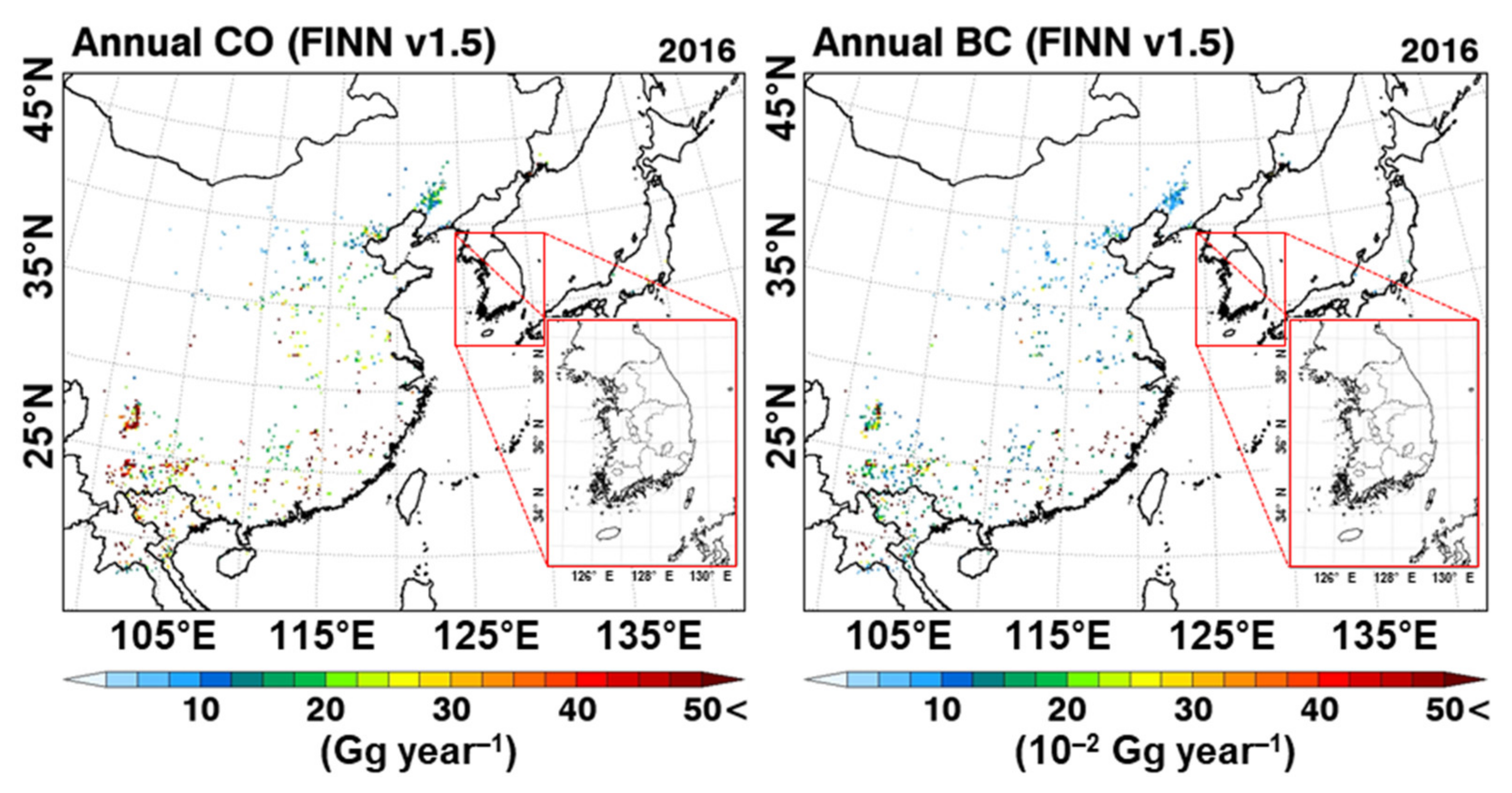
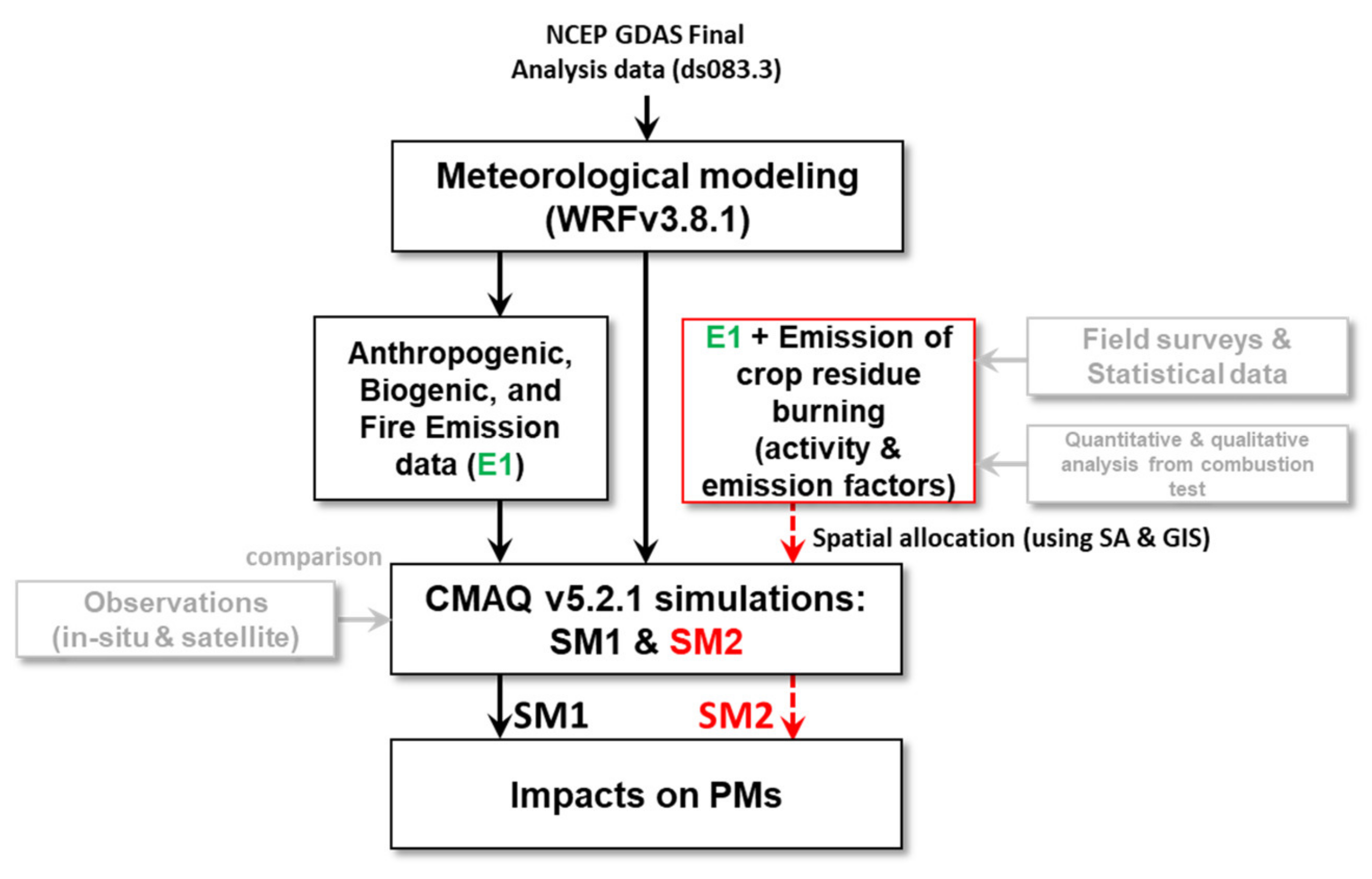
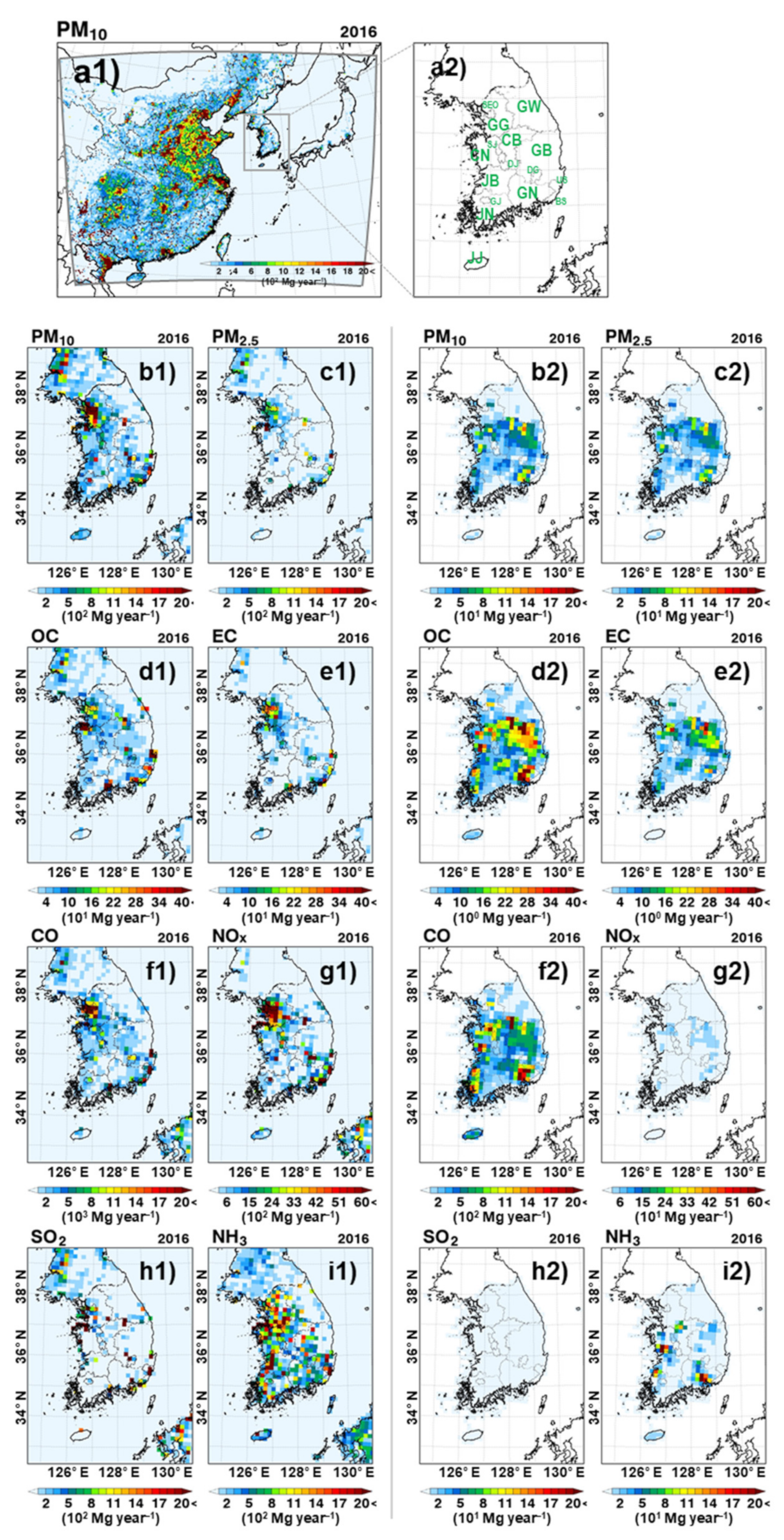
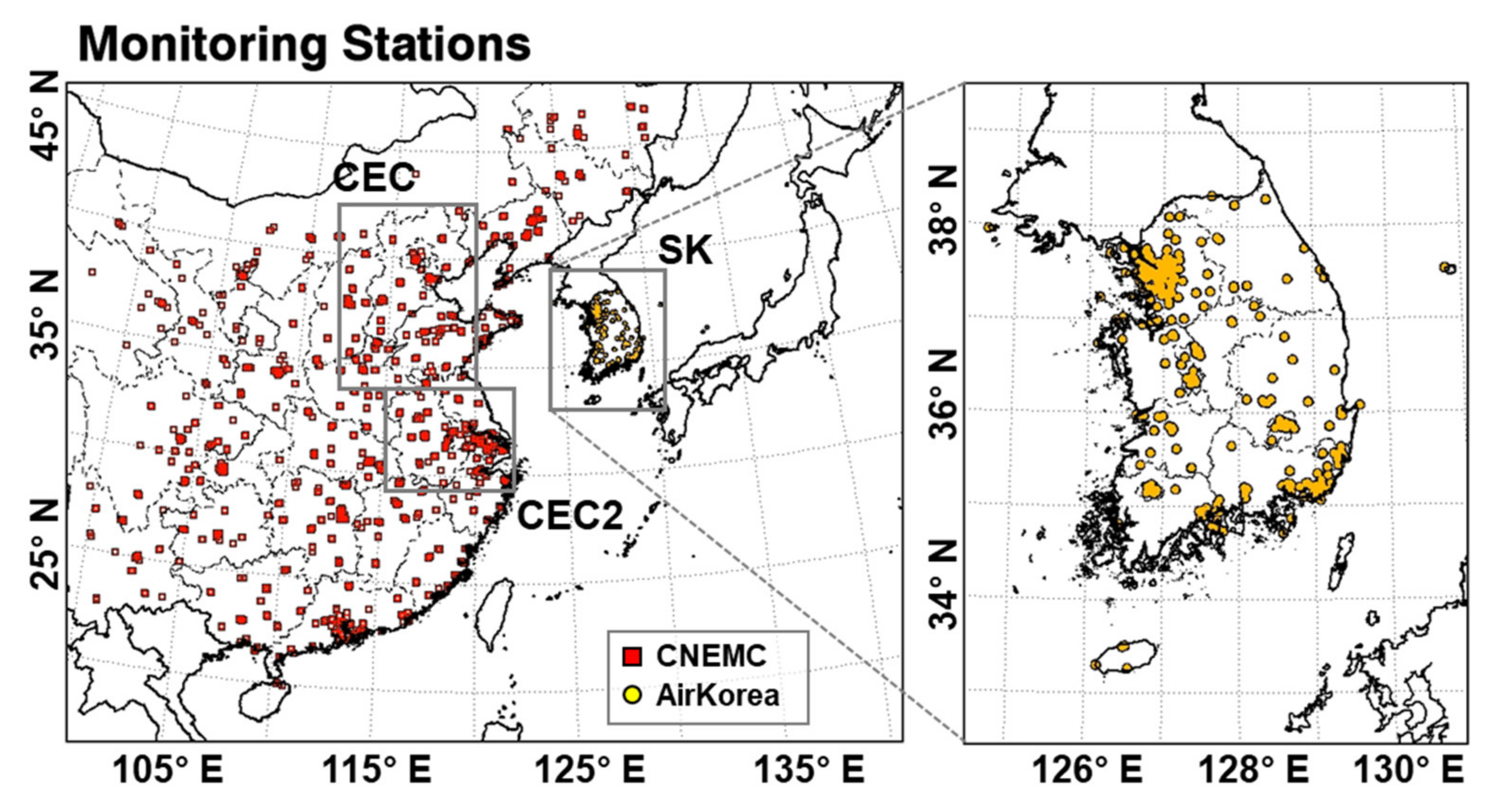
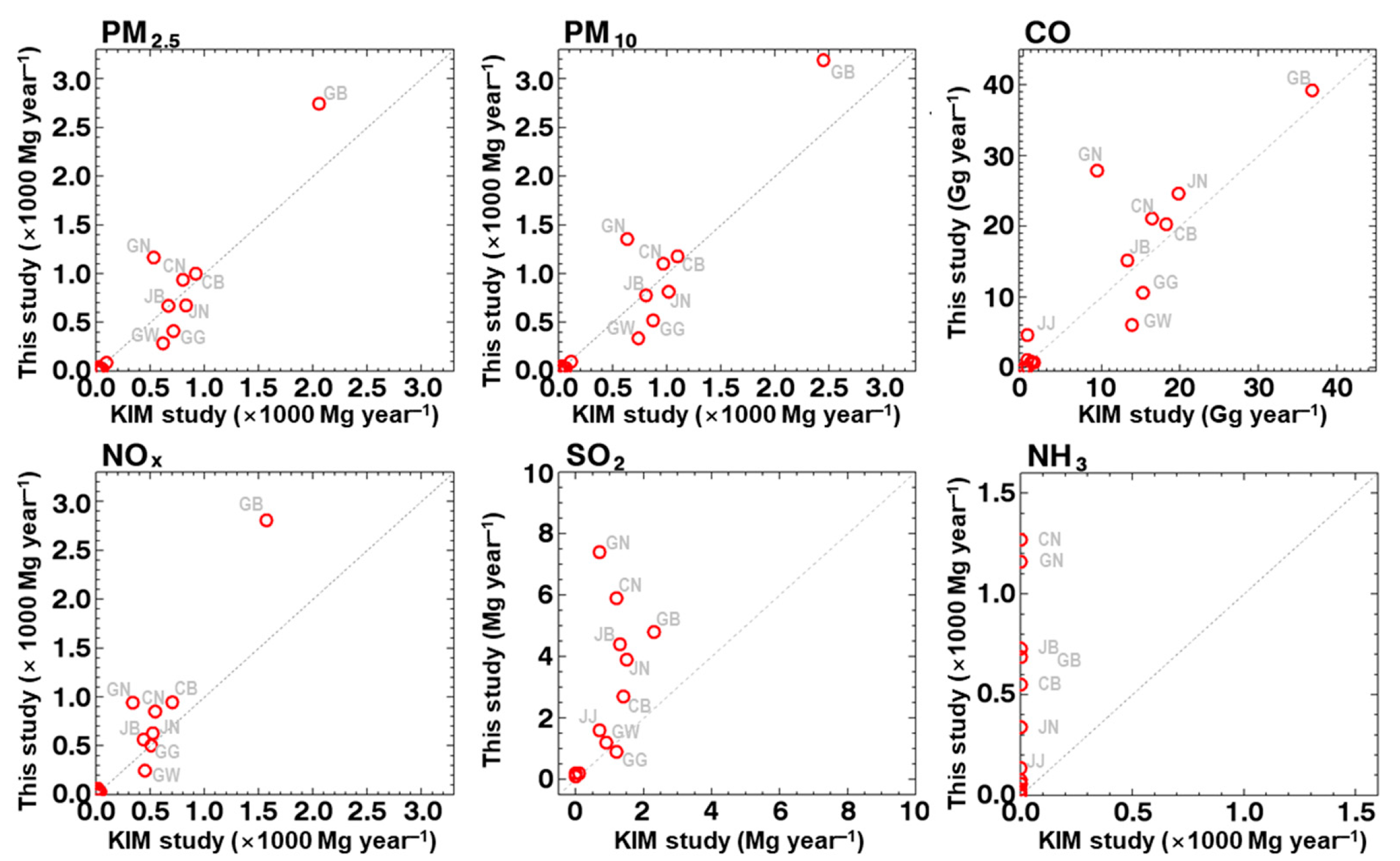
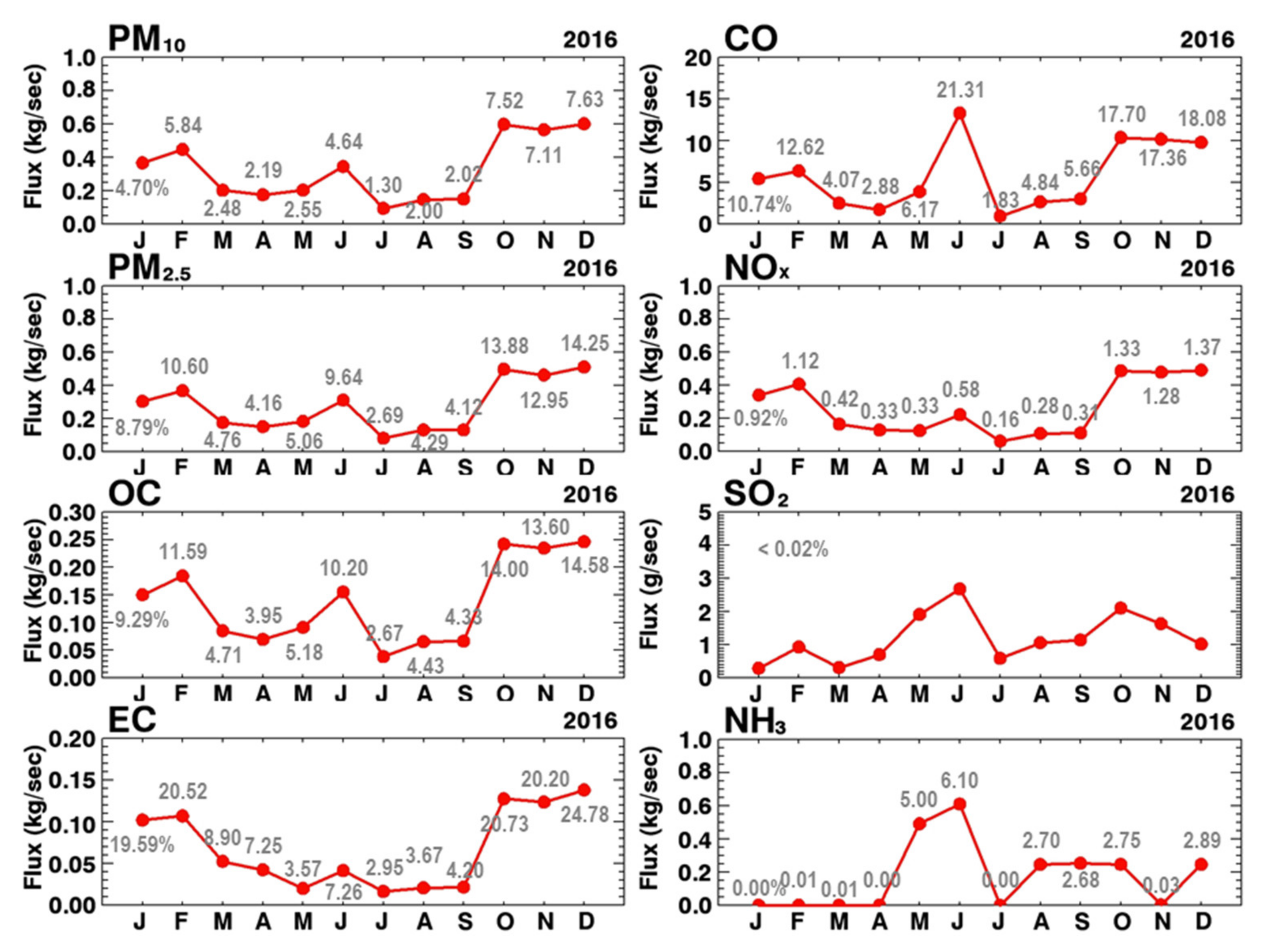
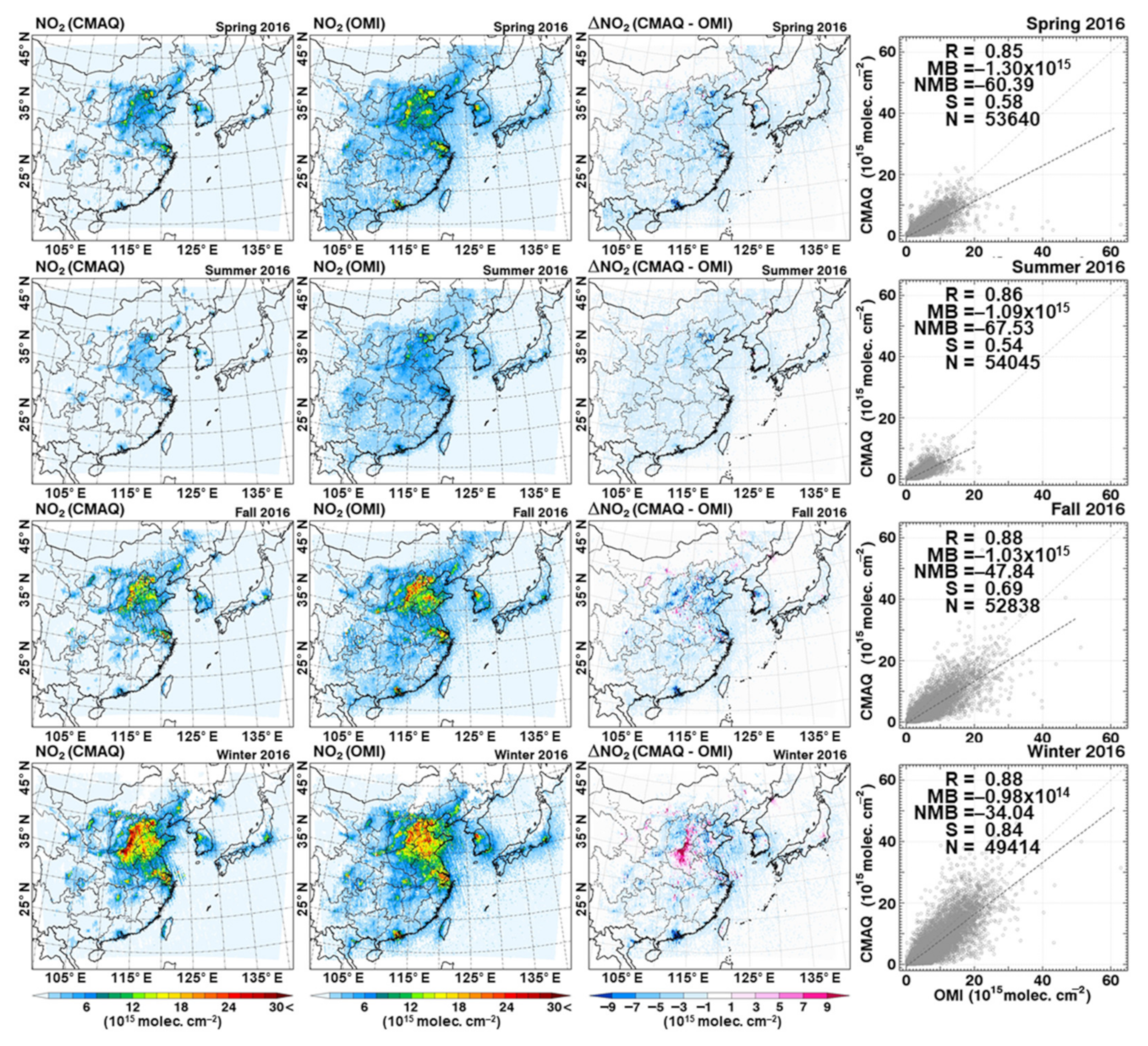


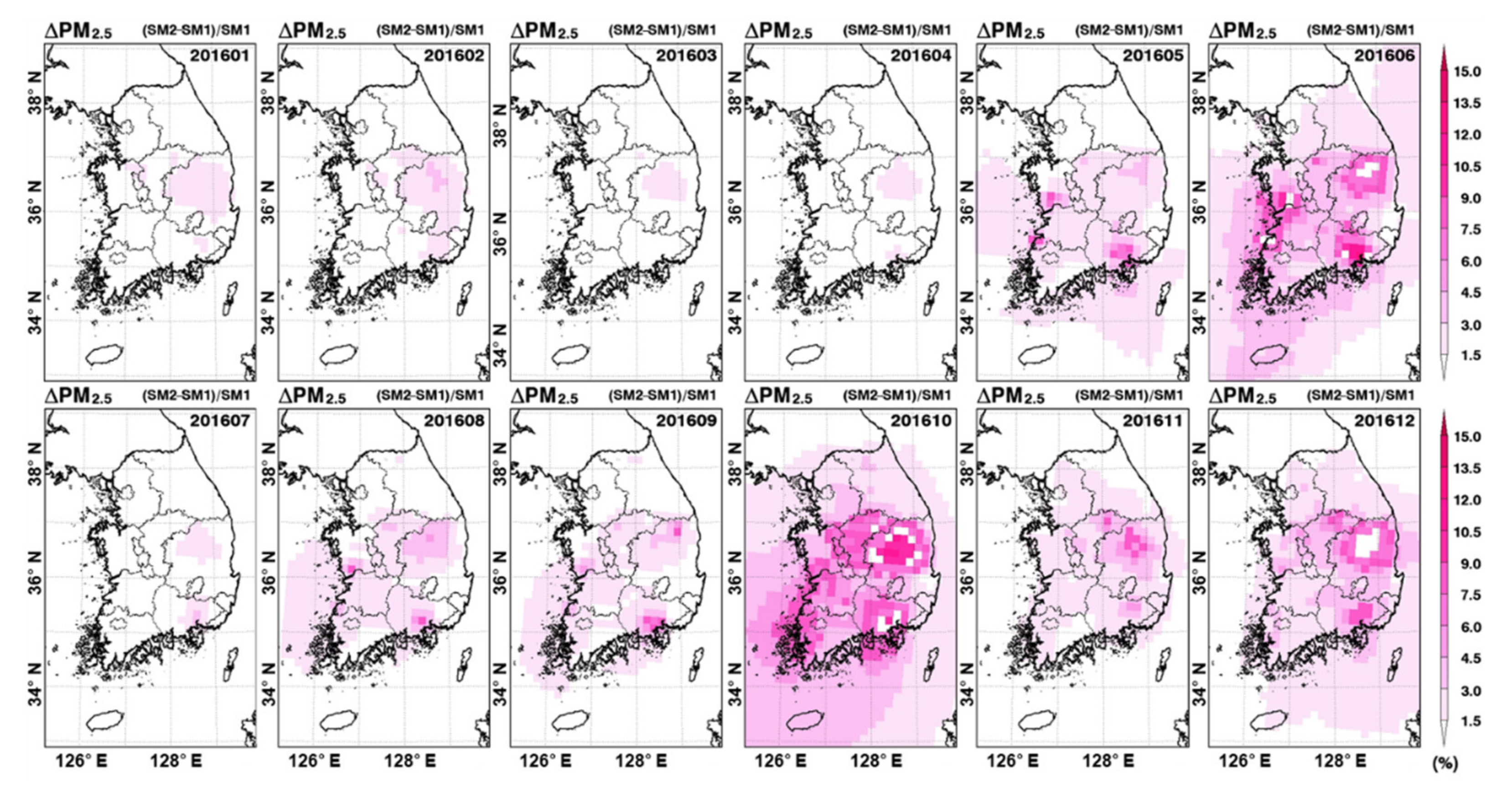
| Refs | Estimation Method | Region | Periods | Parameters | Crops or land Types |
|---|---|---|---|---|---|
| Yang et al., 2008 [17] | B a | China (Suqian) | 2001–2005 | EF b (literatures), DM c (statistical data and field survey) | wheat, legume, rice, corn, potato, oil plant, cotton |
| Zhang et al., 2008 [18] | B | China | 2004 | EF (combustion chamber experiment), DM (field survey) | Rice, wheat, corn straws |
| Jain et al., 2014 [19] | B | India | 2008–2009 | EF (literature [20]), DM (field survey) | Rice paddy, wheat, maize, jute, cotton, groundnut, sugarcane, mustard, millets |
| Das et al., 2020 [11] | B | Nepal | 2003–2017 | EF (literature, [21,22]), DM (literatures) | Paddy, maize, millet, wheat, barley, oil crops, potatoes, sugarcane, jute, pluses |
| McCarty 2011 [23] | T d | USA | 2003–2007 | EF (literatures), DM (US EPA [24]), BA e (MODIS f sensor) | Bluegrass, corn, cotton, rice, soy, sugarcane, wheat, others |
| Liu et al., 2015 [25] | T | China (North Chain Plain) | 2003–2014 | EF (literatures [20,26]), conversion factor [27], BA with FRP g data (MODIS sensor) | wheat |
| Li et al., 2016 [28] | T | China | 1990–2013 | EF (literatures from experiments [29,30]), crop productions with grain-to-straw ratio (Chinese statistical data [31,32]), BA (MODIS sensor) | Wheat, corn, rice, cotton, others |
| Andela et al., 2016 [33] | T for burned crop residue | South America, Sub-Saharan Africa, and Australia | 2003–2014 | Conversion factor [27], BA with FRP data (MODIS and SEVIRI h sensors) | Cropland, woody savanna, savanna, grassland, shrubland |
| Pouliot et al., 2017 [34] | T | USA | 2014 | EF (literatures [23]), BA and fire detection (MODIS, GOES i, and AVHRR j sensors) | Corn, wheat, soybean, cotton, fallow, rice, sugarcane, lentils, others |
| van der Werf et al., 2017 [35] | T [36,37] | World | 1997–2016 | EF (literatures [20,26]), BA with active fire data (MODIS, ATSR k, and VIRS l sensors) | Savanna, Boreal Forest, temperate forest, tropical forest, peat, agriculture |
| Wu et al., 2018 [38] | T | Eastern China | 2003–2015 | EF (literatures [26,39]), DM (literatures), BA (MODIS sensor) | Corn, rice, wheat, cotton, rapeseed, soybean, sugarcane, peanut, potato, tobacco, sesame, sugar beet, coniferous forest, broadleaf forest, mixed forest, grassland, shrubland |
| Yin et al., 2019 [40] | T | China | 2003–2017 | EF (literatures [20]), conversion factor [27], BA with FRP data (MODIS sensor) | Forest, grassland, cropland, shrubland |
| Li et al., 2019 [41] | T | USA | 2011, 2013–2015 | EF (literature [20,26,35]), conversion factor [27], BA with FRP data (GEOS and MODIS sensors) | Forest, Savanna, Shrubs, Grasslands, Croplands |
| Shi et al., 2020 [42] | T | America, Africa, and Asia | 2001–2017 | EF [20], conversion factor [27], BA with FRP (MODIS sensor) | Forest, woody savanna, shrubland, grassland, crop, peat |
| Liu et al., 2019 [43] | B, hybrid-T | NW India (Punjab, Haryana) | 2003–2016 | EF [26], DM (field survey), DM (from GFEDv4 inventory) [35], BA (MODIS sensor with Google Earth Engine) | Rice, wheat |
| Liu et al., 2020 [44] | B, T | India (Punjab, Bihar, Uttar Pradesh, Haryana) | 2003–2018 | EF [45,46], DM (Indian statistic data and literatures [19,47,48,49]), BA with FRP data (MODIS and VIRS sensors) | Rice, wheat |
| Parameterizations | Schemes | Refs. | |
|---|---|---|---|
| WRF | Microphysics | WSM6 | [75] |
| PBL | YSU | [76] | |
| Long and short radiations | RRTMG | [77] | |
| Cumulus physics | Kain-Fritsch (new Eta) | [78] | |
| Land surface | 5-layer thermal diffusion land surface model | [79] | |
| CMAQ | Chemical solver | EBI | [80] |
| Gas phase chemistry | SAPRC-07 | [64,65] | |
| Aerosol process | AERO6 | [66,67] | |
| Horizontal advection | YAMO | [68] | |
| Vertical advection | WRF omega formula with PPM | [81,82] | |
| Horizontal diffusion | Multiscale | [71] | |
| Vertical diffusion | ACM2 | [72,73] |
| Regions | PM10 | PM2.5 | OC | EC | CO | NOx * | SO2 | NH3 |
|---|---|---|---|---|---|---|---|---|
| SEO | 0.0 | 0.0 | 0.0 | 0.0 | 0.0 | 0.0 | 0.0 | 0.0 |
| BS | 0.3 | 0.3 | 0.1 | 0.0 | 4.9 | 0.1 | 0.0 | 0.0 |
| DG | 0.0 | 0.0 | 0.0 | 0.0 | 0.0 | 0.0 | 0.0 | 0.0 |
| IC | 32.7 | 26.0 | 13.7 | 6.2 | 749.0 | 29.4 | 0.2 | 14.4 |
| GJ | 52.0 | 43.5 | 24.8 | 9.3 | 1107.4 | 38.2 | 0.2 | 30.8 |
| DJ | 6.3 | 5.2 | 2.1 | 1.2 | 101.9 | 5.0 | 0.0 | 0.0 |
| US | 40.0 | 30.7 | 11.9 | 13.9 | 838.3 | 43.8 | 0.1 | 0.3 |
| SJ | 25.0 | 20.7 | 10.5 | 4.5 | 562.8 | 26.4 | 0.1 | 31.4 |
| GG | 521.5 | 411.4 | 208.9 | 124.6 | 10,605.2 | 504.9 | 0.9 | 58.4 |
| GW | 337.6 | 285.9 | 140.7 | 62.9 | 6044.8 | 247.3 | 1.2 | 77.0 |
| CB | 1179.3 | 1001.3 | 520.5 | 243.5 | 20,293.1 | 945.8 | 2.7 | 550.8 |
| CN | 1078.5 | 918.1 | 437.4 | 196.9 | 20,552.0 | 824.9 | 5.7 | 1237.9 |
| JB | 778.5 | 672.1 | 332.5 | 127.1 | 15,183.5 | 564.7 | 4.4 | 729.7 |
| JN | 815.1 | 675.9 | 333.3 | 155.0 | 24,625.4 | 629.6 | 3.9 | 338.9 |
| GB | 3192.3 | 2745.6 | 1327.1 | 828.4 | 39,243.3 | 2808.8 | 4.8 | 687.4 |
| GN | 1355.9 | 1166.5 | 600.9 | 229.8 | 27,876.3 | 943.0 | 7.4 | 1160.7 |
| JJ | 98.3 | 86.4 | 37.0 | 6.3 | 4619.1 | 62.6 | 1.6 | 135.6 |
| sum | 9513.5 | 8089.4 | 4001.6 | 2009.5 | 172,407.1 | 7674.7 | 33.1 | 5053.2 |
| PM2.5 | PM10 | |||
|---|---|---|---|---|
| AD (μg m−3) | RD (%) | AD (μg m−3) | RD (%) | |
| January | 0.21 | 0.81 | 0.23 | 0.76 |
| February | 0.21 | 0.91 | 0.24 | 0.86 |
| March | 0.17 | 0.60 | 0.18 | 0.55 |
| April | 0.13 | 0.66 | 0.14 | 0.55 |
| May | 0.29 | 1.79 | 0.31 | 1.33 |
| June | 0.42 | 3.49 | 0.43 | 2.54 |
| July | 0.07 | 0.68 | 0.07 | 0.49 |
| August | 0.17 | 1.60 | 0.18 | 1.06 |
| September | 0.21 | 1.59 | 0.22 | 1.14 |
| October | 0.55 | 4.33 | 0.60 | 3.07 |
| November | 0.34 | 1.97 | 0.38 | 1.67 |
| December | 0.51 | 2.84 | 0.55 | 2.42 |
| PM2.5 | PM10 | |||
|---|---|---|---|---|
| AD (μg m−3) | RD (%) | AD (μg m−3) | RD (%) | |
| January | 0.70 | 2.93 | 0.84 | 2.89 |
| February | 0.77 | 3.35 | 0.84 | 3.36 |
| March | 0.70 | 2.65 | 0.77 | 2.64 |
| April | 0.48 | 2.62 | 0.52 | 2.47 |
| May | 1.23 | 7.31 | 1.26 | 5.10 |
| June | 1.82 | 12.91 | 1.86 | 9.00 |
| July | 0.39 | 3.86 | 0.42 | 2.54 |
| August | 0.75 | 5.54 | 0.80 | 3.76 |
| September | 0.95 | 7.05 | 1.01 | 4.56 |
| October | 1.46 | 10.69 | 1.58 | 8.33 |
| November | 1.03 | 5.93 | 1.21 | 5.71 |
| December | 1.49 | 8.58 | 1.72 | 8.06 |
Publisher’s Note: MDPI stays neutral with regard to jurisdictional claims in published maps and institutional affiliations. |
© 2022 by the authors. Licensee MDPI, Basel, Switzerland. This article is an open access article distributed under the terms and conditions of the Creative Commons Attribution (CC BY) license (https://creativecommons.org/licenses/by/4.0/).
Share and Cite
Han, K.M.; Lee, B.T.; Bae, M.-S.; Lee, S.; Jung, C.H.; Kim, H.S. Crop Residue Burning Emissions and the Impact on Ambient Particulate Matters over South Korea. Atmosphere 2022, 13, 559. https://doi.org/10.3390/atmos13040559
Han KM, Lee BT, Bae M-S, Lee S, Jung CH, Kim HS. Crop Residue Burning Emissions and the Impact on Ambient Particulate Matters over South Korea. Atmosphere. 2022; 13(4):559. https://doi.org/10.3390/atmos13040559
Chicago/Turabian StyleHan, Kyung M., Byung T. Lee, Min-Suk Bae, Sojin Lee, Chang H. Jung, and Hyun S. Kim. 2022. "Crop Residue Burning Emissions and the Impact on Ambient Particulate Matters over South Korea" Atmosphere 13, no. 4: 559. https://doi.org/10.3390/atmos13040559
APA StyleHan, K. M., Lee, B. T., Bae, M.-S., Lee, S., Jung, C. H., & Kim, H. S. (2022). Crop Residue Burning Emissions and the Impact on Ambient Particulate Matters over South Korea. Atmosphere, 13(4), 559. https://doi.org/10.3390/atmos13040559









